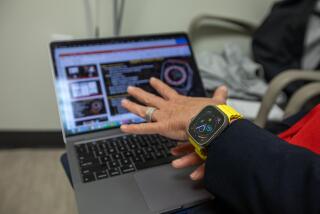Portable Electrocardiograph Tested : New Heart Equipment Saves Time, Lives
- Share via
CHICAGO — Jack Daley says every time he is called to the home of a suspected heart attack victim, the scene is the same.
“You always see the half-eaten roll of Tums, and you can smell Vicks VapoRub all over the place,” the paramedic says. “And you just know the guy’s been sitting around for hours, thinking he’s having indigestion, heartburn, anything but a heart attack.
“All that time he’s been sitting there is time we’ve lost and time we have to make up,” he says. “We can save people’s lives, but we have to have time to do it.”
Time is such an important factor in saving people having heart attacks that the whole issue becomes a subtraction problem.
Treatment Time Limited
The American Heart Assn. says the average heart attack victim waits three hours before calling for help. Medical authorities recognize that they have six hours at the outside to save lives. That leaves, optimistically, three hours to get to a patient, get him to the hospital and get him treated.
So far, the numbers have been working out this way: 1.5 million people have heart attacks every year; about 85% of those who make it to the hospital survive; about 350,000 don’t make it.
Hospital emergency services are hoping that they can fudge the numbers a little to their side either by getting people to the hospital faster, or failing that, getting the hospital to them.
At the University of Chicago Medical Center, paramedics have begun testing a new portable electrocardiograph that will help them diagnose a heart attack at the scene, and which may, down the road, allow them to administer life-saving drugs to a patient even before he reaches the hospital.
Provides Basic Information
Although most ambulances are equipped with ECG machines, they can provide only basic information, such as whether a patient has gone into cardiac arrhythmia or arrest, says Dr. Pamela Grim, a senior resident in emergency medicine at the university center.
“It is impossible to diagnose a (heart attack) with those ECGs,” she says. “Not difficult. Impossible.”
The new system, developed with the university’s help by Marquette Electronics in Milwaukee, is nearly identical to the more sophisticated ECGs found in hospitals themselves.
The university, in cooperation with Daley Ambulance Service, has used the portable ECG in at least 50 suspected heart attack calls with good results. The ECG correctly diagnosed the five people who were actually having heart attacks, and ruled out heart attack in the 45 others.
Such a system, if proved accurate over a larger trial, would have some important applications, Grim says. Used alone, the cellular ECG could provide a diagnosis before the patient reached the emergency room, allowing treatment to be given as much as 45 minutes earlier.
“Something like this could potentially save a lot of time,” Grim says. “And time equals lives.”
More to Read
Sign up for Essential California
The most important California stories and recommendations in your inbox every morning.
You may occasionally receive promotional content from the Los Angeles Times.












